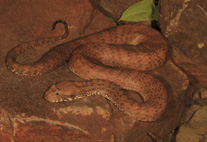Abstract
The deep-water crangonid Parapontophilus occidentalis (Faxon, 1893) is endemic to the eastern Pacific and has been reported from Mexico to Chile, in depths of 837–4082 m. Material collected off the west coast of the Baja California Peninsula (BCP) during the TALUD XV, XVI and XVI-B cruises consists of a series of 136 specimens (M:F = 1:3.6) with 30 % of ovigerous females. The material examined was captured in depths of 1296–2093 m. Size ranged from 8.4 to 16.1 mm CL, with females being significantly larger than males. Number of eggs carried by ovigerous females ranged from 7 to 998, without a significant relationship between female size and number of eggs. Using only data of females carrying at least 100 eggs, egg mass weight varied from 0.036 to 0.181 g. Size of oval-shaped eggs also varied considerably (0.515 to 0.922 mm). Larger densities of P. occidentalis were observed between 1700 and 2100 m, where larger individuals were collected, and sex proportions differed across all depth strata. At the northern BCP, P. occidentalis was collected at dissolved oxygen concentrations from 0.76 to 1.83 ml l-1, at temperature from 2.1 to 3.4°C, and salinity from 34.54 to 34.63 kg g-1. Density of P. occidentalis was positively correlated with dissolved oxygen, salinity, and silt contribution to sediments, and negatively correlated with temperature and primary productivity five months before sampling.

